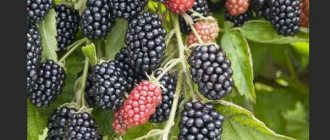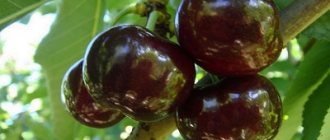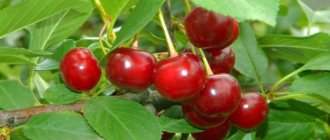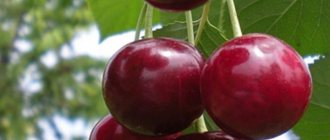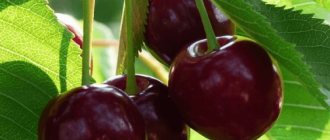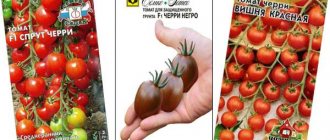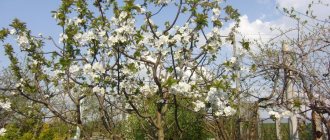Cherry trees are a horticultural symbol of Russia, but over the past half century, due to an unprecedented invasion of fungal infections, more than 2/3 of orchards across the country have been destroyed, and the old famous varieties cannot cope with the onslaught of diseases and pests. They are being replaced by new varieties, and one of the outstanding creations of breeders was the Volochaevka cherry variety.
History of selection
Volochaevka cherry was obtained by a group of breeders under the leadership of Evstratov A.I., working at the Federal State Budgetary Institution VSTISP (All-Russian Breeding and Technological Institute of Horticulture and Nursery Growing).
The institute is located in Moscow and Evstratov A.I. famous for the fact that from his hands came numerous varieties of cherries that are resistant to one of the terrible scourges of cherry trees - coccomycosis, and are also quite winter-hardy in the climate of the Moscow region and the entire Central region.
Attention! The Volochaevka cherry variety is unique in that it was obtained from crossing the most famous and ancient cherry varieties, known since the 18th-19th centuries, Vladimirskaya and Lyubskaya.
The variety was obtained back in the 80s of the last century, but due to the difficult economic and political situation in our country, it received registration in the State Register of Breeding Achievements of Russia only in 1997. The variety is officially approved for cultivation in the Central region, but this only means that it is in this region that all the fruit and yield properties of the Volochaevka cherry will be optimally revealed. In reality, the Volochaevka variety is grown with pleasure by gardeners throughout Russia, south of the Moscow region.
Harvest and storage
Fruiting of Volochaevka begins in the 4th year of life. An adult tree produces a harvest of up to 15 kg.
Cherry is not a crop whose fruits are picked prematurely, since the berries do not ripen, remaining sour. You can’t let it overripe, otherwise most of the fruits will fall off and rot. In the southern regions, the berries ripen in early July, in the central regions - in the middle of the month, and in northern climates - at the end of July.
The collection is carried out in dry weather, in the morning or evening, when the sun is not too active. For storage or transportation, cherries must be collected together with the stem or part thereof. For further processing, the fruits can be picked without the petiole. In this case, you need to take into account that the berries will only be stored for 2-3 days, and then they will begin to deteriorate.
If the cherries are harvested during a rainy period, most likely the berries will be sour and their shelf life is much shorter. It is better to process such a harvest for winter harvesting.
For storage, fruits with petioles are placed in wooden boxes and placed in a dry room at a temperature of 0...-2°C and air humidity at 90%.
The Volochaevka cherry variety is worthy of the attention of farmers: it has excellent taste characteristics, high annual yields and many other advantages. Even a beginner in gardening can cope with growing crops.
Description of culture
Cherry trees of the Volochaevka variety can be classified as medium-sized, since they reach a height of 3 – 3.5 meters.
The crown of the trees has a beautiful rounded shape, the density of dark green rather large ovoid leaves with a crenate edge is slightly above average.
The shoots are straight and have a brown tint. A tree of this variety bears fruit on last year's shoots and on bouquet branches. Young shoots of the current year bear only vegetative buds.
Judging by many reviews from gardeners, Volochaevka cherry fruits are quite large in size, although in the description of the originator variety, the average weight of one fruit is about 3-4 grams.
Apparently, the size of the fruit, as well as their taste, is largely determined by the climatic conditions of the growing area and the composition of the soil.
Because half of the gardeners speak of Volochaevka cherry berries as very tasty, sweet, and even dessert, while others consider them to be the most ordinary.
The color of the fruits, as well as their juice, is characterized by a rich red color. This means that Volochaevka cherries can rightfully be classified as morels or griots.
Comment! All varieties of common cherries, depending on the color of the fruit juice, are divided into two groups: moreli (griots) and amoreli. In Amorels, the color of the fruit is light, and the juice is completely colorless.
The pulp of the fruit is quite dense and at the same time very juicy. A small stone is easily separated from the rest of the fruit. Tasters rate the taste of Volochaevka cherries at 4.7 on a five-point scale.
The fruits contain 15.6% dry matter, 10% sugar, 1.4% acid and 22 mg/% vitamin C.
Proper preparation of cherries for winter
The emphasis is on smoking and concealment. The space located under the tree crown is covered with snow and mulch. A simple manipulation slows down the onset of flowering, which guarantees a problem-free winter. To carry out smoking you will need peat or sawdust, which is set on fire. Plumes of dense smoke will protect the cherries from the cold. The only drawback of the described technique is that even an experienced gardener is not always able to correctly calculate the direction of the wind.
Characteristics
The characteristics of the Volochaevka cherry variety have many positive aspects for amateur gardeners and especially beginners in gardening.
Winter hardiness, drought resistance
Volochaevka cherry is distinguished by quite decent winter hardiness, at the level of one of its parents - Vladimir cherry. Trees tolerate frosts down to -30°C relatively calmly, but the buds can be damaged by returning spring frosts.
The drought resistance of this variety is average, however, when grown in the conditions of central Russia, more is not required. And for the southern hot and arid regions there are varieties that are more suitable for this characteristic.
Pollination, flowering period and ripening time
One of the unique features of the Volochaevka cherry variety is its self-fertility. That is, in order for the cherry to form fruits after flowering, it does not need other varieties of cherries or sweet cherries growing nearby. In addition, bees or bumblebees or other insects are essential for cross-pollination. But in recent years, due to the increasingly complex environmental situation, bees and other insects are not always present in household plots. And the self-fertile Volochaevka cherry variety can provide you with delicious fruits in any year and in any weather conditions, regardless of the presence of pollinating insects and other cherry trees nearby.
Therefore, this variety is simply a godsend for owners of small plots or those who, due to small free space, can afford to plant only one variety of cherries.
The Volochaevka cherry blossoms in May; depending on the growing region, the flowering period may be shifted to the first or second half of the month.
But according to the timing of berry ripening, most gardeners classify it as a mid-ripening variety, while some even call it mid-late.
The fact is that the fruits of this variety usually ripen in the second half of July. In the southern regions, berries may ripen earlier - in early July.
Productivity, fruiting
Volochaevka cherry can be called a rather early-fruiting variety. After all, trees grow to quite decent sizes, and they begin to bear fruit already in the 4-5th year of life, when the height of the tree reaches about three meters.
Moreover, the yield of a five-year-old tree can be up to 10 kg of cherries under favorable conditions. In this regard, the Volochaevka cherry was significantly ahead of its parents.
Comment! The average yield of Vladimir cherries is about 45 c/ha, while up to 100 c/ha are collected from industrial plantings of Volochaevskaya cherries.
The maximum yield of adult Volochaevka cherry trees in orchards can be up to 12-15 kg per tree.
The average lifespan of a tree is about 15 years, and in the southern regions, cherries can bear fruit for more than 20 years.
Area of application of berries
The berries of the Volochaevka variety are universal in use. Since they have a dessert, pronounced cherry flavor, they are enjoyed fresh. But their various drinks and preparations for the winter are also good.
Resistance to diseases and pests
Initially, the Volochaevka cherry variety was bred as resistant to coccomycosis. Indeed, his resistance to this disease is above average. Although in especially rainy years trees may still be affected by this disease, they recover after appropriate treatments.
The Volochaevka variety has average resistance to other diseases and pests, and preventive spring treatments can help protect trees from trouble.
Advantages and disadvantages
| Advantages of the variety | Disadvantages of Volochaevka cherries |
| Self-fertility | Average resistance to many diseases |
| Large and tasty berries | |
| Good yield |
Description of the Volochaevka cherry variety, tree characteristics, planting and care rules
A description of the popular Volochaevka cherry variety will allow you to decide on the choice of fruit tree to plant on your site. The variety is characterized by productivity and is easy to grow.
History of origin
To obtain the new Volochaevka variety, Lyubskaya and Vladimirskaya cherries were crossed. In 1997, the new variety was entered into the State Register as a fruit tree intended for cultivation in the Central part. Volochaevka was bred by breeder A.I. Evstratov.
Description of the variety
It is important to study the description of the variety before choosing a cherry variety so as not to be disappointed. Volochaevskaya is characterized by high frost resistance.
But at a temperature of -30 degrees, the shoots freeze, which negatively affects the health of the tree.
Volochaevka is a self-fertile variety, so to increase productivity you do not have to plant other varieties of cherry trees in the garden. Or attract bees to the garden for pollination.
Appearance
Another important point that you need to study before purchasing a seedling is the appearance of the tree. Attention is paid to the height of the trunk, the density of the crown and the characteristics of the fruit.
Tree
Volochaevskaya cherry variety reaches a height of no more than 3 m. The tree is heavily leafy, the crown is thickened. The leaves are dark green, matte.
Fruit
Ripe fruits are large, weighing on average 4-5 g. The peel is thin, red-scarlet in color. The seed is not large and is easily separated from the pulp. The flesh is a rich burgundy color. The taste of the berries is sweet, with a slight sour taste. The fruits are suitable for preparing various dishes and canning.
Characteristics of the variety
Important characteristics of any variety are productivity, fruiting period and resistance to various diseases and insects.
Productivity
Fruiting of the hybrid begins in the 4th year after planting the seedling. Productivity is good; at least 15 kg of fruits are collected from an adult tree. The tree bears fruit every year. The first ripe cherries appear at the end of July.
The fruiting period suggests that Volochaevka belongs to the late cherry hybrids.
Disease resistance
The resistance of the Volochaevka variety is average. It should be noted that cherries have good resistance to coccomycosis and monilial burn. To prevent the occurrence of diseases, trees are regularly inspected and preventive procedures are carried out.
Features of cultivation
Planting is an important moment during which the foundation for future productivity and health of the cherry is laid. If you plant a seedling according to all the rules of agricultural technology, the cherry tree will produce a good harvest every year.
Choosing a landing site
It is recommended to plant the variety in April. To plant seedlings, preference should be given to open, sunny, elevated areas. Cherry does not like stagnant water near the trunk, as often happens in the spring in the lowlands. Areas that are in partial shade are also suitable. It is not recommended to plant plants in places where the sun's rays do not reach.
Landing
Planting the Volochaevka hybrid is no different from planting other cherry varieties. Stages of planting Volochaevskaya cherry:
- Dig a hole at least 1 m deep and at least 70 cm wide.
- Pour manure, nitrogen-containing fertilizers and wood ash into the bottom of the hole.
- Leave the pit with fertilizer for 2-3 weeks.
- Before planting a seedling, dip it in a growth activator for several hours, and just before planting, dip the roots in an aqueous solution of clay.
- Place the seedling in the hole and cover it with soil.
- Compact the soil near the trunk.
- Drive a stake into the center of the hole and tie the trunk of the seedling to it.
Landing Features
Volochaevka cherry is an unpretentious variety, but planting must be done according to all the rules in order to get the maximum from the tree that it is capable of.
Recommended timing
In most regions of the central zone, for which the cultivation of cherries of this variety is recommended, it is better to select a seedling for a permanent place in the spring, around April, even before the buds open. Only residents of the southern regions can afford to plant cherries in the fall. If the seedling was only obtained in the autumn, then gardeners in the middle zone are better off burying the cherry tree in a secluded place in the garden, covering it with earth on all sides.
Choosing a suitable location
The ideal place for planting cherries would be a south-eastern or southern slope, maximally illuminated by the sun. Volochaevka can grow in partial shade, but this will certainly not have the best effect on the taste of the berries.
Groundwater must be at a considerable depth, at least 1.5 meters. As a last resort, the cherry tree can be planted on a small artificial mound. Soils should be well drained and fertile. Usually, having dug a hole for planting a tree in advance, they mix the soil with sand, wood ash, humus and a complex of fertilizers, and then only cover the roots of the seedling with this mixture.
Which cultures are friends or enemies with cherries?
For cherries, the proximity to representatives of the stone fruit family: cherries, plums, cherry plums, and sloe will be very favorable. But it is better to plant peach and apricot further away.
Among the shrubs, honeysuckle will be a good neighbor, but it is better to plant raspberries, currants and gooseberries at a considerable distance from cherries, since they have many common enemies. For the same reason, proximity to vegetables from the nightshade family: peppers, tomatoes, eggplants will be unfavorable.
Large trees with a huge root system can shade the cherry and take away nutrients from it, so cherries are planted at a great distance from birch, spruce, oak, linden, and poplar. It is also better to plant apple and pear trees at a distance of at least 10 meters from the cherry tree.
But rowan, hawthorn, elderberry and grapes will be good neighbors for cherries.
Selection and preparation of planting material
Choose seedlings only in garden centers, where they will provide you with detailed information about the variety, type of rootstock, and age.
The root system should be well developed with a sufficient number of thin suction roots. There should be no damage to the bark on the shoots.
6-8 hours before planting, place the cherry roots in a solution with root.
Landing algorithm
Important! If you are planting several trees, the distance between them should be at least 3.5 meters.
It is advisable to dig a hole for planting in advance, in the fall. On heavy clay soils, it is necessary to arrange a drainage layer of gravel or sand at the bottom of the planting hole with a height of at least 8-10 cm. First, a column is strengthened in the center of the hole, then the straightened roots of the cherry seedling are placed around it. They begin to gradually fall asleep with the prepared soil mixture. The root collar and grafting site of grafted seedlings should not be deepened into the ground, so it is better to leave them slightly at the top. After filling the hole, pour 1-2 buckets of water over the planting site and compact the soil between the roots.
It is better to immediately mulch the planting site with organic matter and maintain this layer by adding mulch 1-2 times per season.
Cherry Volochaevka: description of the variety and characteristics of the tree, planting and care
Detailed description of the Volochaevskaya cherry variety: large size, juicy, dark red fruits weighing up to 4.5 g, late ripening, with a very good taste, resistant to.
Features of planting and growing.
1. General information about cherries. Useful properties of cherries.
Cherry berries have been widely used in folk medicine since ancient times. Cherry is a dietary product; it increases appetite and improves the digestion process. Cherry fruits have a slight laxative effect.
Cherry has antiseptic and anti-inflammatory properties. Cherry juice quenches thirst at elevated temperatures. Traditional medicine recommends eating a kilogram of fresh cherries a day for a month, washing them down with 7-8 glasses of milk - this helps with arthritis and sclerosis. Cherry has a beneficial effect on the central nervous system; its decoction was used for mental illness and epilepsy.
The coloring pigment anthocyanin is highly digestible, as it is distributed throughout the fruit pulp. Cherries also contain a lot of coumarin, a substance that reduces blood clotting. This feature of cherries allows it to be used to prevent a number of complications of arterial atherosclerosis, and the successful combination of vitamins C, B1, B6, iron, magnesium, cobalt, and pigments in cherries is used to prevent and treat anemia.
Cherry – contains hematopoietic microelements: iron, copper, cobalt, which makes it possible to use it for anemia. Pectin substances help remove nitrogenous waste from the body. Cherry pulp contains bactericidal substances. Cherry juice is used for mental illness, arthritis, as a mild laxative, expectorant, thirst quencher and appetite enhancer. Cherries contain ellagic acid, which prevents the development of malignant tumors by blocking the growth of cancer cells. And the presence of anthocyanidins in berries helps reduce uric acid levels in the body. In addition, regular inclusion of cherries in the diet greatly reduces the risk of gout.
Ascorbic acid in combination with P-vitamin active tannins and cherry pigments tone, strengthen blood capillaries, reduce high blood pressure, and increase the body's resistance to adverse effects, in particular, to increased background radiation. Eating cherries reduces the frequency and severity of heart attacks.
2. Choosing a place for cherries.
– Cherry requires a well-lit place. Otherwise, a decrease in the sugar content of the fruit and a general decrease in yield are possible.
– Cherry is far from the most frost-resistant crop. In this regard, it is recommended to plant next to country houses (between a barn and a bathhouse, a house and a fence). The best place for cherries is sunny, covered on the north side by a brick wall, which, when heated, will not only protect from cold winds, but also damage the tree.
– Cherry does not tolerate stagnant water. If there is a possibility of flooding on the site, the tree should be drained if possible or planted on a hill. Otherwise, the tree will have poor development or even death. The groundwater level should be at least 1.5-2 m.
– Cherry grows best on light sandy or loamy soils. On heavy clay or sandy soil, cherries most likely will not develop. In this case, a good landing hole is required. The acidity of the soil should be close to neutral: pH 6.5-7.0.
3. Cherry planting and care.
– Planting of seedlings can be carried out exclusively in the spring (for bare root plants), and from spring to September (for containerized plants).
– Cherry seedlings should not be buried when planted in the ground. The root collar (the place where the root enters the trunk) should be 5-7 cm above ground level.
– When buying a seedling in the spring, you can immediately prune the branches. You can't cut the roots. The more of them a young tree has, the faster it will take root. The roots can only be straightened.
– Almost all varieties of cherries growing in the Moscow region are considered self-sterile, that is, they need pollen from another plant to set fruit. Accordingly, you should keep this in mind and if you or your neighboring plot does not have another tree (another variety of cherry), you should purchase it immediately. Even in self-fertile varieties, yields increase significantly when a pollinator appears. There is also an opinion that although cherries and cherries practically do not cross-pollinate, they have a beneficial effect on each other.
Subsequent care of the crop
In the middle zone, additional watering of Volochaevka cherries is required only during the first year after planting or if the weather is particularly dry and hot.
Feeding should be started only from the beginning of the fruiting period. Usually they are carried out twice a season - during the flowering period or immediately after and during the period of fruit formation. You can fertilize with humus or a complex of mineral fertilizers with microelements in the form of chelates.
Attention! A circle of cherry trees with a diameter of about a meter must be regularly weeded from weeds or kept constantly under mulch.
Cherry pruning consists of sanitary pruning, aimed at removing dry and damaged branches, and shaping. It is most convenient to form the crown of a tree in the form of a ball, cutting out all the branches that thicken the crown.
In late autumn, tree trunks are coated with garden paint to protect against sunburn and rodents.
Advice! If a variety of rodents are active in your area, then it is advisable to wrap the stem of a young seedling in the first few winters with roofing felt or plastic bottles cut lengthwise.
In the conditions of the middle zone, no additional winter protection is provided for the Volochaevka cherry.
Advantages and disadvantages
Purple cherry
Advantages of the variety:
- relative frost resistance, recommended for cultivation in central Russia;
- ease of care;
- characteristic “cherry” taste of the fruit;
- relative resistance to fungal diseases (especially coccomycosis).
Flaws:
- not suitable for arid areas and areas with very harsh winters (less than −30°C);
- small fruits.
The Volochaevskaya cherry variety has gained popularity among private gardeners and industrial farms in central and southern Russia due to its unpretentiousness and high taste qualities of the fruit.
0 0 votes
Article rating
Pests and diseases
| Type of problem | Way to fight |
| Fungal diseases | It is safer to use biological products. A mixture of trichodermin and baxis (1:1) is effective. Treat all summer after the temperature has reached about +12°+15°C. In the autumn after harvesting, spray the trees with 1% Bordeaux mixture |
| Pests | In the fall, after the first frost, they are sprayed with a 5% urea solution, and starting in early spring, every 25 days they are treated with biological products Fitoverm, Akarin |
Regular disease prevention
You need to be more wary of coccomycosis, the enemy of almost all varieties of cherries. Its first sign will be a brown coating that appears. It is localized on the underside of the leaf. Over the course of several days or weeks, the leaf becomes deformed and falls off. If the tree is sick, then after harvesting the leaves must be destroyed.
All about runes for beginners - rules for studying symbols and layouts
In severe cases of coccomycosis, the tree is treated with Bordeaux mixture and urea. Another formidable enemy of the Volochaevka variety is moniliosis. Provokes rapid drying. You can notice it by the characteristic growths on the surface of the bark.
Damaged areas are immediately removed and burned. Treating wood with a mixture of copper chloride, Bordeaux mixture and ferrous sulfate will help reduce the likelihood of developing the disease. In addition to the diseases already mentioned, the Volochaevka variety is susceptible to a number of others:
- perforated spotting - provokes rapid drying of fruits and leaves;
- anthracnose – characteristic bumps and spots form on the fruits;
- gum discharge - a colorless liquid called gum is actively released.
In addition to diseases, the gardener must be aware of the most common pests that threaten cherries. We are talking about aphids, weevils, and slimy sawflies.
Variety Flora
Cherry fruit flora
This variety was developed at the Sverdlovsk Horticulture Breeding Station.
The author of the species is M. G. Isakova. The height of the tree is almost 2 m. The crown is very spreading and fluffy. This cherry is self-fertile.
The size of its fruit is approximately 5 g. The fruits have a pleasant sour taste and red color.
The variety is characterized by winter hardiness (varieties such as Chernokorka and Revna also tolerate winter well). Resistant to diseases. Gives a large amount of harvest.
